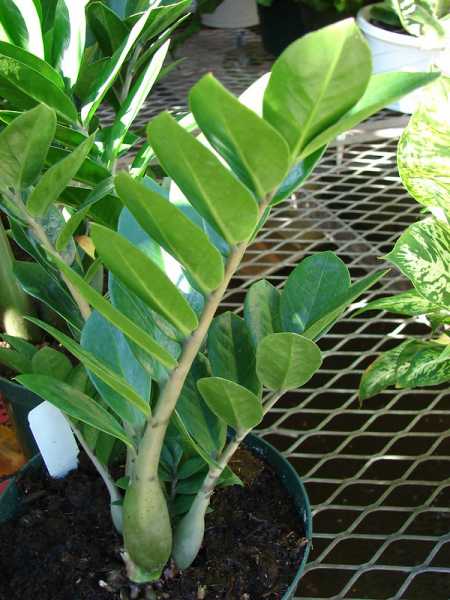Potting soil for your zz plant is a combination of garden soil, vermicompost and sand. It’s a medium in which you can grow plants, herbs and vegetables in a container or pot.
Apart from sand, perlite, grit and vermiculite, you can include coconut coir or peat moss and limestone in potting soil. Here we use black grit not just for improving drainage but to improve air and water flow.
Generally fertilizers are not added for potting soil because it is too aggressive for them. You can use fertilizers for larger plants.
The zz plant can easily grow in the nutrient rich and porous soil mix. For improve aeration of soil combine regular potting soil with cacti or perlite soil. This plant doesn’t like to stand on wet soil for a long period so avoid garden soil.
The medium will play an essential role for every plant growth. This plant was not fussy with their soil mix but the correct soil composition will boost the plant growth quickly.
In this write-up you’ll know right soil composition required for your house plant in particularly zz plant.
What Type of Soil Does ZZ Plant Require?

It can be intimidating for a new parent plant to know the soil composition elements and consider the perfect soil composition for your zz plant.
Here are the few factors that we recommend you to consider before selecting the soil composition for ZZ plant. These include:
- How the nutrients rich in the soil?
- Does the soil drain well?
- Does the soil hold some moisture?
- How is the aeration in the soil?
The above questions are needed to be check when you are looking for plating ZZ plant. These plants can be grow from the rhizomes through the roots comes out and then leaves and stems grow from the top.
For growth and flourish, the plant needs rich nutrient potting medium and if the soil have lack of nutrients will result in improve growth.
Secondly, make sure the potting mix is well drained and it permits the simple water flow and nutrients flow for the higher growth of the plant.
The garden soil is heavy and it will block the airflow and water, because the soil is too light and it will not resist the water at all. Here, we require a soil composition which is well drained and well aerated, but at the same time must grasp the water and nutrients for the plant growth.
Zz plant will prefer the dry or moist soil but not soggy.
Though the potting medium must hold moisture but being moist for longer hours can trigger fungal growth. So, the soil composition must have holding capacity of moisture in moderation apt for zz plant.
Your ZZ plant soil must be well aerified, if it is closely packed then oxygen flow will block and retain the soggy soil for bacterial and fungal growth and root rot.
Don’t be afraid or confused about the soil composition for your ZZ plant and it can easily fulfil your plants needs.
If you’re not sure what to do, simply follow the composition that I have tried and tested.
Also Read: Can You Put a Peace Lily Outside?
Best Potting Soil Mix for ZZ Plant
Fortunately, your ZZ plant is not very picky about the growth medium because it is one of the most resilient plants in the market.
But, we need to thrive our ZZ plant, not just to survive, we may need to help it, mature quickly.
These are hardy plants, and when planted in suitable potting soil, they can thrive as long as they receive proper care and nutrients.
Use a mixture of perlite, peat and even sand (sometimes) to ensure proper drainage of the plants.
However, if you want to prepare potting soil for ZZ plants, mix regular potting soil with the cactus mixture to ensure good drainage and fast nutrition intake.
(Also Read: Do Pothos Need Drainage?)
The cactus mixture contains perlite, limestone and sand, making it a porous and well-draining mixture and also ensures proper root growth.
Let have a look on my recipes that will works well with all ZZ plants.
Recipe no. 1
- ¾ share of organic potting soil in a container
- ¼ share of succulent mixture
- Handful of compost
Recipe no.2
- ¼ share of potting soil
- ¼ share of peat
- ½ share of coarse or perlite sand
Grind three parts of potting soil into a single part of cactus mixture to start with and the cactus mix will help to improve the draining capacity as well as soil’s air space.
Another way to improve soil drainage is to add perlite to the mixture. Perlite brightens the soil structure and promotes better absorption of nutrients and water.
Add 1/2 share of perlite to 1/4 share of potting mix and you can also add 1/4 of peat.
The above options will produce positive results and it will protect your ZZ plants from soaking in water for a long period.
Can I Use Cactus Soil for ZZ plants?
As an ideal, if the soil of ZZ plant dries out between watering. Cactus soil is an excellent choice for your ZZ plant because it can quickly absorb water and drain water quickly.
Although cactus soil is very effective for ZZ plants, it can keep plants dry for a long time, resulting in prolonged drooping and brown leaves.
I recommend mixing something that can keep moisture at a certain level and may be very suitable for your houseplant.
Mix high-quality potting soil with the cactus mixture to improve water retention, while having good drainage and coarse mixed particles. It will also provide nutrients to plants and promote root growth.
Ideal mixture is 1/2 part cactus soil, 1/4 part potting soil, and 1/4 part peat.
Also Read: Why Is My Fiddle Leaf Dropping Leaves?
Do ZZ Plants Like Acid Soil?
ZZ plants like slightly acidic soil.
The ideal pH value range set by ZZ plant is between 6.0-7.0. Make sure the soil is not too sour, as this will burn the leaves and stunt of the ZZ plant.
Any pH range around 6.5 is ideal for ZZ plants.
When Should I Transplant My ZZ plant?
ZZ plants have a good growth rate and their roots are rhizomes. You need to know your ZZ plant to determine when to replant it.
The roots grow vigorously, and when the roots come out of the holes, it indicates that the plant needs to be transplanted. Other signs that your ZZ plants indicate that they need to be transplanted are:
- Withering leaves
- Browning leaves
- Stunted growth
- Pots break down started
- Excessive root growth
These signs should be detected immediately and ZZ plant should be transplanted.
It is recommended to transplant in summer and spring, because winter is the dormant period, transplanting will affect the growth of plants.
Do not fertilize immediately after transplanting, let them adapt.
Ideally, you should repot your ZZ plant within 2-3 years, because the transplantation will not cause any harm if necessary. It can promote your overall health and growth.
